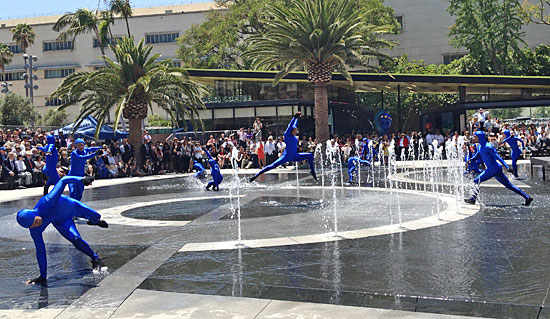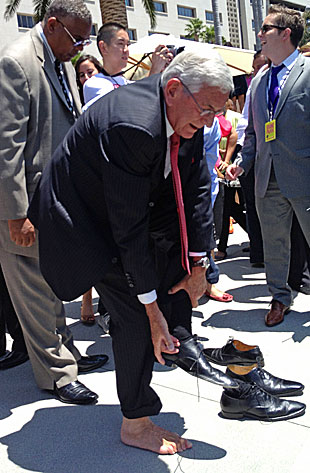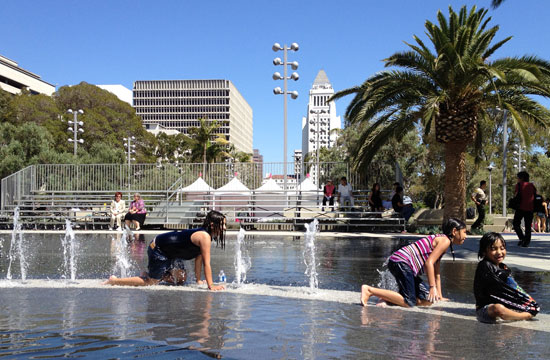
Dancers splash in the Arthur J. Will fountain’s new “membrane pool” during Thursday’s dedication ceremony.
It’s big, it’s wet and it’s already making a big splash as the first segment of Los Angeles’ Grand Park opened this week.
The 6,200-square-foot pool in front of the restored Arthur J. Will Memorial Fountain has only a quarter-inch of water, but it’s likely to be a huge crowd magnet, says Jim Garland, president of Fluidity Design Consultants, which oversaw the fountain’s restoration and expansion.
“It’s going to be awesome,” says Garland. “There’s a similar pool around the Millennium Park Fountain in Chicago, and kids roll around in it, and people just love it, and it’s probably the most popular fountain today in the United States.”
But under the sleek, nonslip surface and its inviting jets of water, an elaborate system of machinery and maintenance workers will be hustling around the clock to keep that expanse—technically known as a “membrane pool”—clean. The pool’s filtration system was kept separate from the one used for the fountain itself, Garland says, because health codes set a higher standard of cleanliness for interactive water elements.
Every drop will circulate every half-hour through an underground filtration and disinfection system that will kill bacteria with ultraviolet light and chlorinate the water. Security guards will patrol to ensure that no one abuses the pool area or mistakes it for a bathtub. And the crews that monitor the fountain at the Dorothy Chandler Pavilion will manually test for cleanliness at least three times daily.

Barefoot in the park: Dignitaries like Eli Broad are among the first to take the plunge after Thursday’s ribbon-cutting.
“It’s about a 10 minute test—we just take a water sample and drop in a tablet,” says Keith McTague, director of building services and chief engineer at the Music Center. “We’re mainly doing it as a check and balance on the filtration system, which is automatic, and so that the readings are documented. But if we have to do it more often, we will.”
These safeguards are crucial because, while the historic Will Memorial Fountain was designed to keep people out of its waters, the adjacent membrane pool was conceived as a way to entice kids and grown-ups alike into getting wet.
“Nobody was sure there would be money for an interactive area like that,” Garland says. “But…we all fought to keep it in.”
Much of the inspection and testing of the system will rest with the Department of Public Health environmental health unit which, among other duties, acts as the county’s “fountain police.”
Chief Environmental Health Specialist Bernard Franklin says the Grand Park membrane pool is different from the roughly two dozen other interactive fountains throughout the county. Most of those, he says, are “splash pads” in which water spurts from a dry deck surface—not like Grand Park, where jets are placed in an ever-present layer of water.
In fact, Franklin says, the Grand Park pool will be the last of its kind in the county after September, when revisions to the California Building Code and the California Code of Regulations will prohibit pools of standing water in fountains that encourage public interaction with the water.
Franklin, who helped author the new rules, says that while the Grand Park pool will be well maintained, others with a lesser design or oversight could generate potentially unhealthy conditions. “Pools like these can be big collectors if you’re not careful,” he says. “Dirt gets in them, pigeons and ducks come around them, people try to use them in ways they aren’t supposed to.”
To that end, camera monitors and round-the-clock security will be in place to discourage mischief and enforce rules that will, among other things, ban camping and skateboarding in the park.
The results promise to be well worth it.
As the designer Garland puts it: “At night, you’ve never seen anything like it. It’s going to be magical.”

After the official dedication, the real fun begins for the kids.
Posted 7/26/12






